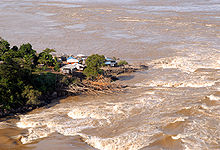| Jirau Dam | |
|---|---|
 Site of the Jirau Dam | |
| Official name | Usina Hidrelétrica Jirau |
| Location | Rondônia, Brazil |
| Coordinates | 9°16′00″S 64°38′57″W / 9.26667°S 64.64917°W |
| Status | Operational |
| Construction began | December 2008 |
| Opening date | December 2016 |
| Construction cost | US$8 billion |
| Owner(s) | ESBR |
| Operator(s) | Jirau Energia |
| Dam and spillways | |
| Type of dam | Embankment, concrete gravity composite |
| Impounds | Madeira River |
| Height | 63 m (207 ft) |
| Length | 1,500 m (4,921 ft) |
| Dam volume | 2,000,000 m3 (70,629,333 cu ft) (embankment) |
| Spillway type | Overflow, 21 controlled gates |
| Spillway capacity | 82,000 m3/s (2,895,803 cu ft/s) |
| Reservoir | |
| Surface area | 258 km2 (100 sq mi) |
| Power Station | |
| Operator(s) | Jirau Energia |
| Commission date | 2013–2016 |
| Hydraulic head | 15.10 m (50 ft) |
| Turbines | 50 x 75 MW bulb turbines |
| Installed capacity | 3,750 MW |
| Annual generation | 19 100 GWh |
| Website www | |
The Jirau Dam is a rock-fill dam with an asphalt-concrete core, in the Madeira River in the state of Rondônia, Brazil. The dam's hydroelectric power stations have 50 turbines each 75 MW resulting total installed capacity of 3,750 MW. The power plant's first unit was commissioned in September 2013,[1] the 16th in November 2014,[2] 24th in February 2015,[3] the 41st in December 2015,[4] and the last in December 2016.[5] Most of the power is designed to be exported to south-eastern Brazil via the Rio Madeira HVDC system.
The dam is part of a planned four power plant Madeira river hydroelectric complex, which will consist of two dams in Brazil (3,580 MW Santo Antônio Dam at the city of Porto Velho and Jirau), a third on the border of Brazil and Bolivia, and a fourth station inside Bolivia. Two of these, Santo Antonio and Jirau, are already operating, while the smaller upstream dams are still in the planning stages. In part due to the 2001–2002 power shortage in Brazil, construction of both dams was accelerated in 2009. The total estimated cost of the two facilities currently under construction is $15.6 billion ($8 billion for Jirau), including about $10 billion for the civil engineering and power plants, and $5 billion for ship locks, transmission lines, and environmental re-mediation.[6] The Madeira river hydroelectric complex is part of the Initiative for the Integration of the Regional Infrastructure of South America, an effort by South American governments to integrate the continent's infrastructure with new investments in transportation, energy, and communication.[7] Construction on the project was temporary halted in March 2011, February 2012 and April 2013 due to worker riots or strikes.[8][9]
The Brazilian Development Bank approved an additional US$1.6 billion for the project in September 2012. The extra funding will add six more 75 MW bulb turbine-generators to the power station (a total of 50) and pay for transmission lines.[10]
- ^ Enerdata: First 75 MW turbine commissioned at 3,750 MW Jirau dam
- ^ "Aneel authorizes 16th turbine hydroelectric Jirau, in Rondônia". Rondonia. 4 November 2014. Retrieved 26 January 2015.
- ^ Harris, Michael (27 February 2015). "Commissioning of turbines at Brazil's 3,750-MW Jirau nearing halfway point". HydroWorld.com. Retrieved 1 August 2015.
- ^ "UHE Jirau fecha o ano com 41 turbinas em operação". Energia Sustentável do Brasil. 22 December 2015. Archived from the original on 17 February 2017. Retrieved 1 February 2016.
- ^ "Archived copy" (PDF). Archived from the original (PDF) on 28 April 2019. Retrieved 23 August 2017.
{{cite web}}: CS1 maint: archived copy as title (link) - ^ "Brazil to Build $15.6 Billion in Dams in Amazon Region". Water World – PennWell Corporation. Retrieved 2 April 2011.
- ^ José María Díaz Batanero (February 2010). Initiatives for the Improvement of the South American Market of Roaming Services Analysis and Recommendations (Report) (in Spanish). IIRSA. Retrieved 7 July 2011.
- ^ The New York Times: Amid Brazil’s Rush to Develop, Workers Resist
- ^ "Workers remain on strike in hydro Jirau and Santo Antônio". Reuters (in Portuguese). 11 April 2013. Archived from the original on 4 March 2016. Retrieved 1 June 2013.
- ^ "Brazil's development bank approves new loan for Jirau dam". Reuters. 28 September 2012. Retrieved 26 February 2013.[dead link]
